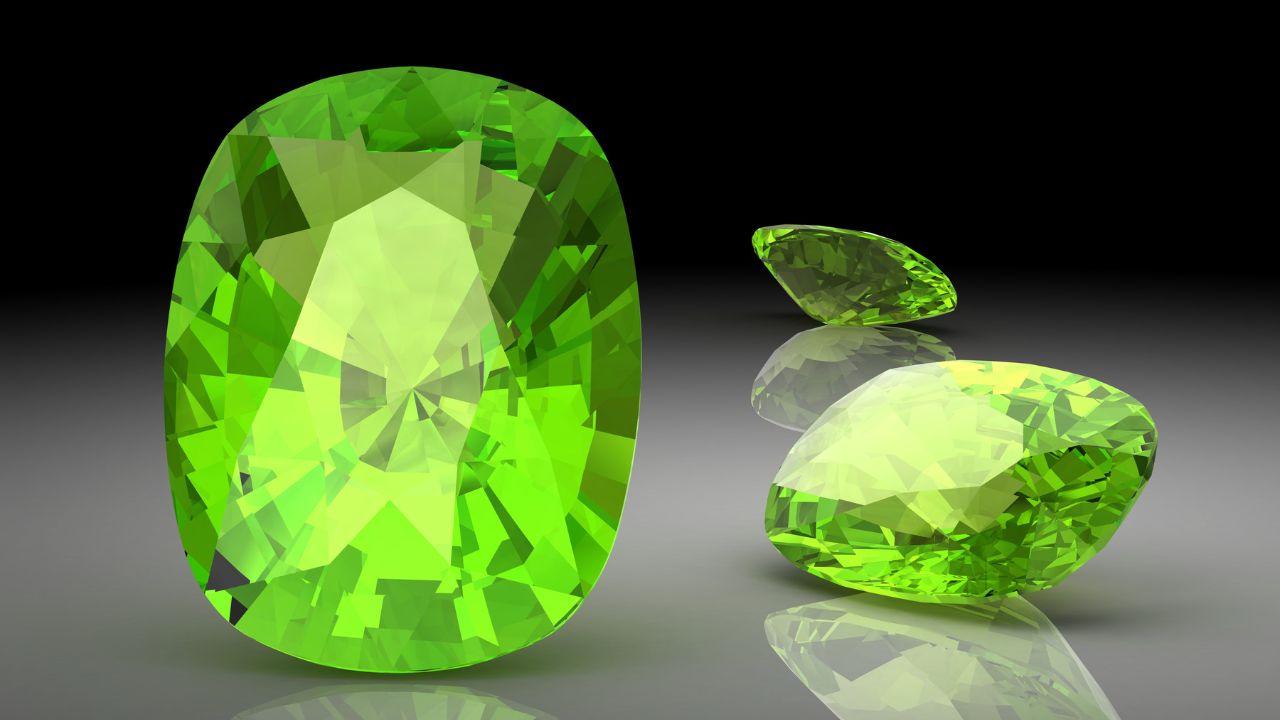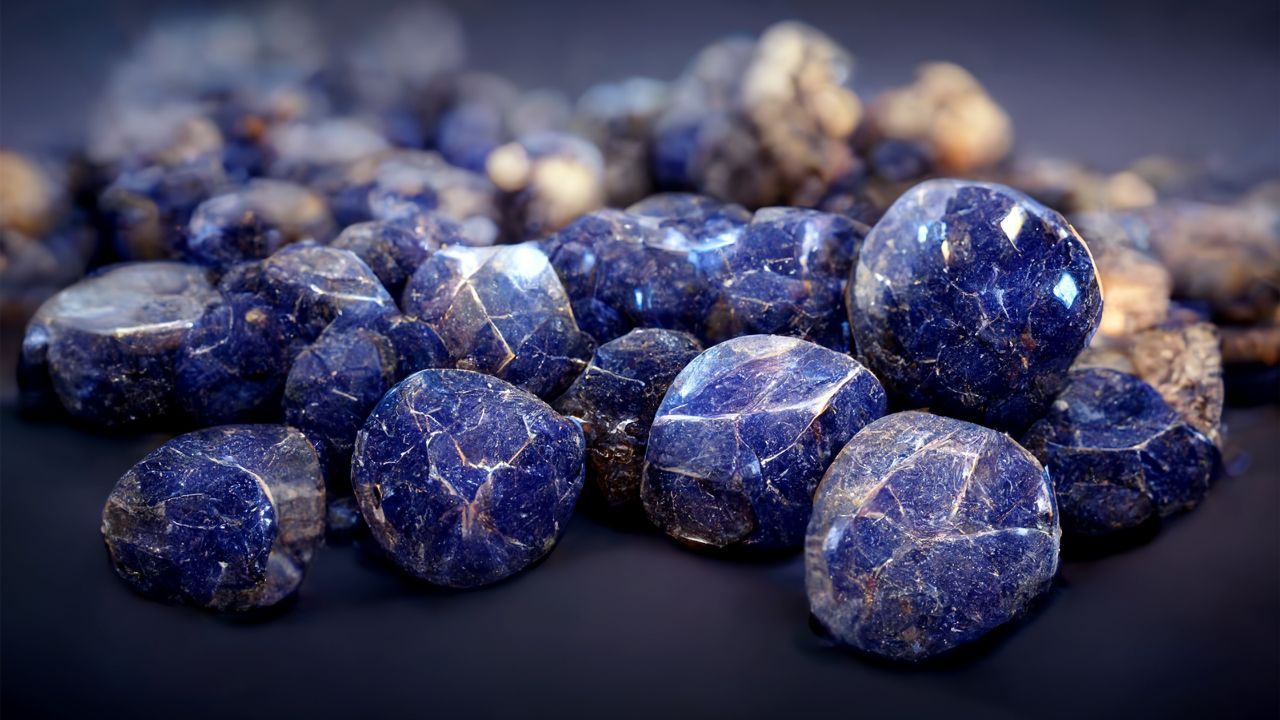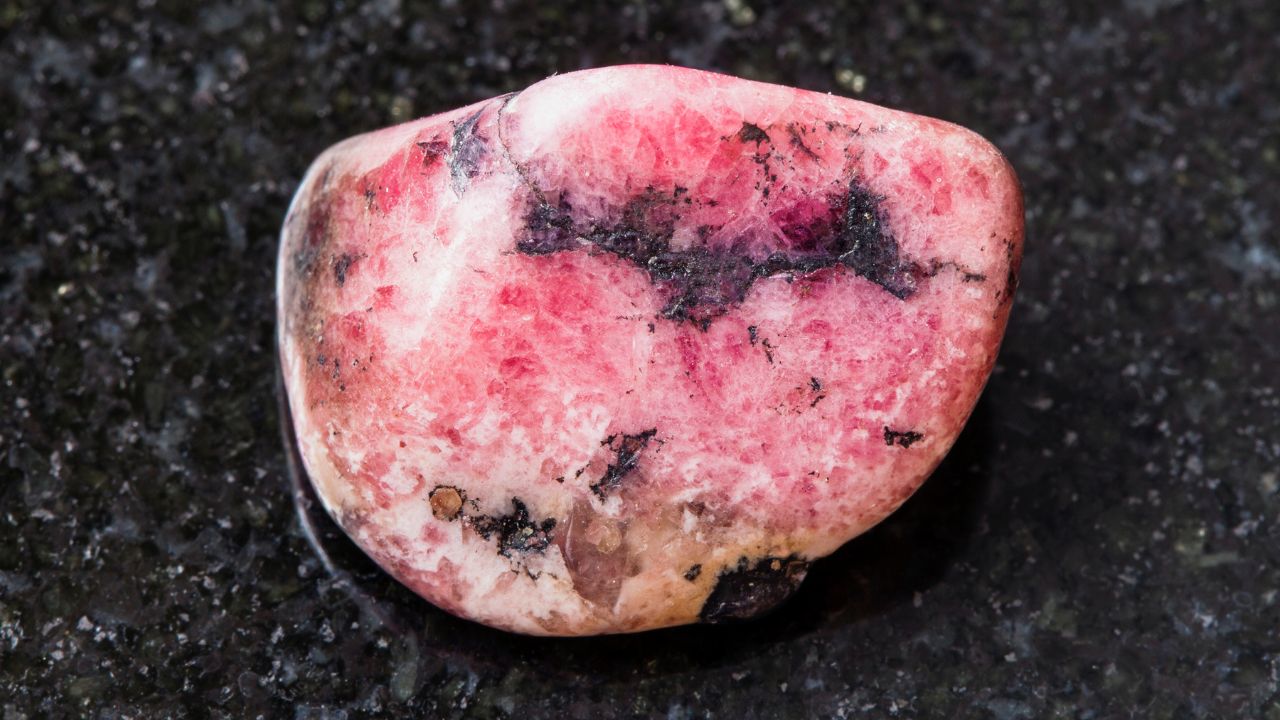
Where is the Gemstone Rhodonite From?
Rhodonite, a captivating gemstone admired for its pink to rose-red hues and striking black dendritic veins, has origins deeply rooted in various parts of the world. This article aims to delve into the origins of rhodonite, uncovering the sources and mining locations where this gemstone is found. By uncovering where rhodonite comes from, we gain a deeper appreciation for its beauty and rarity.
From the vast landscapes of Russia to the mines of Australia and the deposits in North America, rhodonite is sourced from diverse locations globally. Understanding the origin of this gemstone offers valuable insights into its availability and market demand.
Understanding Rhodonite: Characteristics and Composition
Rhodonite, a manganese silicate mineral, possesses distinct traits and properties that make it a unique gemstone. This section delves into the various aspects of rhodonite, including its chemical composition, physical properties, and notable variations such as fowlerite and bustamite.
Defining Rhodonite's Unique Traits
Rhodonite is renowned for its striking pink to rose-red color, often accompanied by contrasting black dendritic veins that create captivating patterns. These distinctive traits make rhodonite highly sought after in the gemstone industry.
Additionally, rhodonite is well-known for its exceptional durability and hardness, scoring 5.5 to 6.5 on the Mohs scale. This durability allows for the creation of durable and long-lasting jewelry pieces.
Another remarkable characteristic of rhodonite is its translucent to opaque nature, which adds depth and visual appeal to the gemstone.
Rhodonite's Chemical and Physical Properties
The chemical composition of rhodonite consists of manganese, silicon, and oxygen, represented by the molecular formula MnSiO3. The presence of manganese gives rhodonite its distinctive pink hue.
Physically, rhodonite often forms in masses or granular aggregates, with a typical rhombohedral crystal structure. It showcases a vitreous to pearly luster, enhancing its overall allure.
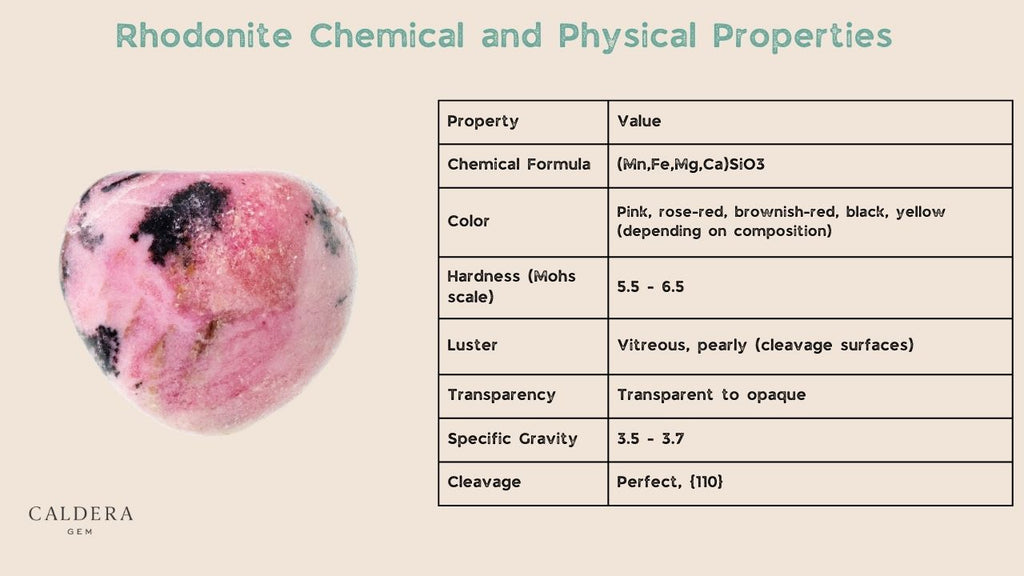
Variations of Rhodonite: From Fowlerite to Bustamite
While rhodonite is captivating in its own right, variations of the mineral offer unique characteristics and appearances. Fowlerite is a rare variety of rhodonite that exhibits a striking green color due to the presence of zinc. This distinctive shade sets fowlerite apart from traditional pink rhodonite.
On the other hand, bustamite is another notable variation of rhodonite that features a more robust brown to deep reddish-brown color. This variation is often sought after by collectors and gemstone enthusiasts due to its intense and warm hues.
Exploring the Major Sources of Rhodonite Worldwide
Rhodonite comes from around the world. To understand rhodonite's market value and availability, one must understand its main sources.
Russia is a major rhodonite producer. Russia, particularly Sverdlovsk, has contributed to the rhodonite industry due to its mining history. Russian rhodonite is prized for its vivid hue and black veins.
Rhodonite is also found in Australia. New South Wales has many rhodonite crystals and mines. The market craves Australian rhodonite because of its high quality and unique qualities.
Canadian rhodonite deposits include British Columbia's. This location produces exquisitely colored and clear rhodonite, contributing to its market diversity.
Rhodonite is abundant in Brazil, recognized for its gemstones. Brazilian rhodonite is known for chatoyancy and other intriguing occurrences. Rhodonite's global availability is increased by the country's production.
Rhodonite is also found in the US, South Africa, and Europe. These sources are essential to meeting rhodonite demand and supplying gem enthusiasts worldwide.
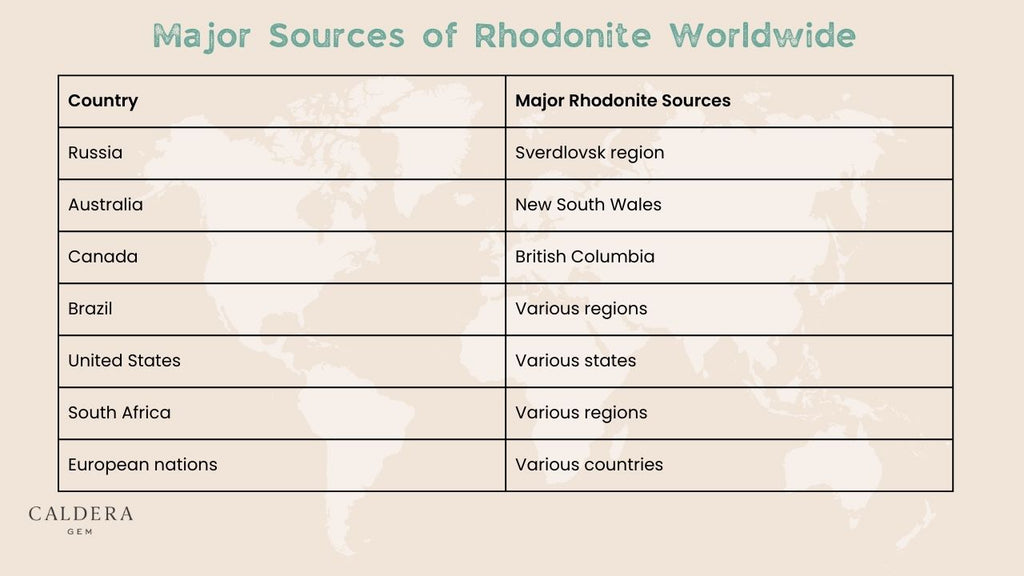
To visually illustrate the major sources of rhodonite, the table below provides an overview of the different countries and their contributions:
| Country | Major Rhodonite Sources |
|---|---|
| Russia | Sverdlovsk region |
| Australia | New South Wales |
| Canada | British Columbia |
| Brazil | Various regions |
| United States | Various states |
| South Africa | Various regions |
| European nations | Various countries |
By exploring these major sources of rhodonite from around the world, individuals can gain a better understanding of the global availability and diverse origins of this stunning gemstone.
Australia is renowned for its significant role in the rhodonite industry, serving as a prominent provider of this captivating gemstone. With its vast mineral resources, Australia has become a key destination for those seeking high-quality rhodonite.
One notable region within Australia where rhodonite is found is New South Wales. This state boasts a rich abundance of rhodonite crystals and mines, making it a hub for rhodonite enthusiasts and experts alike. These mines in New South Wales contribute to Australia's reputation as a major player in the global rhodonite market.
When it comes to comparing Australian rhodonite to specimens from other regions worldwide, Australian rhodonite stands out for its exceptional characteristics. The gemstone exhibits a remarkable pink to rose-red color, often accented with intricate black dendritic veins, creating a stunning and unique visual appeal.
| Comparison Criteria | Australian Rhodonite | Rhodonite from Other Regions |
|---|---|---|
| Color | Pink to rose-red with black dendritic veins | Varies across regions |
| Quality | High-quality specimens with excellent clarity | Quality may vary |
| Availability | Abundant supply from New South Wales mines | Dependent on mining sources |
North America's Rhodonite Deposits
North America boasts several noteworthy rhodonite deposits, contributing to the gemstone's availability in the region. The prominent rhodonite findings in North America are a result of both Canadian and American mining efforts. British Columbia in Canada and various states in the US play a significant role in the rhodonite industry.
Canadian Finds: British Columbia's Contribution
British Columbia, located in western Canada, is renowned for its rich rhodonite deposits. The province's diverse geology and mineral-rich terrain have led to the discovery of high-quality rhodonite. British Columbia's contribution to the rhodonite market has made Canada a key player in the gemstone's production.
The American Gem: Rhodonite Mines Across the US
The United States is home to numerous rhodonite mines spread across various states. These mines extract rhodonite from different regions, contributing to the overall availability of North American rhodonite. The US's significant rhodonite deposits make it an important player in the global rhodonite industry.

Rhodonite Mining in Russia and Beyond
Sverdlovsk, a famous region in Russia, has a long history of rhodonite mining. Sverdlovsk, located in the Ural Mountains, is well-known for its high-quality rhodonite deposits. Russian rhodonite is a sought-after gemstone in the market due to the region's long history in the rhodonite business.
Aside from Russia, Europe and Africa also contribute to rhodonite supplies. European countries such as Bulgaria, Romania, and Norway have significant rhodonite deposits that yield gem-quality stones. South Africa is a key rhodonite producer on the African continent, contributing to the global supply of this attractive gemstone.

Spotlight on Brazilian Rhodonite's Unique Characteristics
Brazilian rhodonite is renowned for its distinct qualities that set it apart from other varieties of rhodonite. This section focuses on the exceptional characteristics of rhodonite from Brazil, shedding light on its unique attributes and contributions to the rhodonite market.
Chatoyancy and Other Phenomena in Brazilian Rhodonite
One of the remarkable features of Brazilian rhodonite is its chatoyancy, also known as the "cat's eye" effect. This optical phenomenon creates a captivating display of shimmering bands or streaks that resemble the eye of a feline. The chatoyant effect adds an extraordinary allure to Brazilian rhodonite, enhancing its beauty and desirability.
In addition to chatoyancy, Brazilian rhodonite may exhibit other intriguing phenomena, such as asterism (the phenomenon of producing a star-like pattern when cut en cabochon) or color-changing properties. These captivating optical effects contribute to the uniqueness and value of Brazilian rhodonite in the gemstone market.
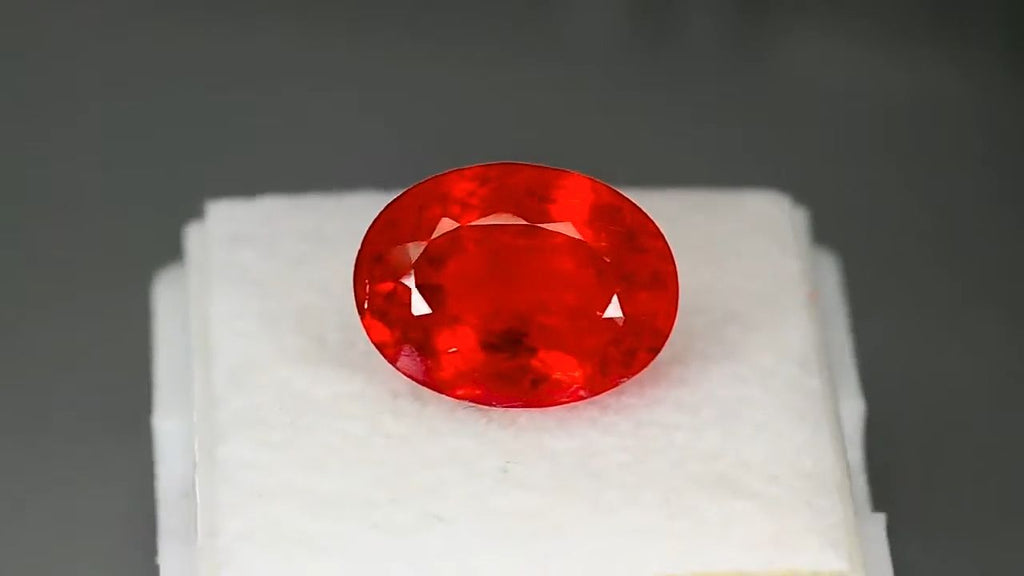
Brazil plays a significant role in the global rhodonite market. The country is known for its abundant deposits of high-quality rhodonite, which are sought after by gemstone enthusiasts and collectors worldwide. Brazilian rhodonite stands out for its vibrant hues of pink and red, as well as its captivating patterns and markings.
With its rich reserves and skilled artisans, Brazil supplies a substantial portion of the world's rhodonite demand. The country's expertise in mining and lapidary craftsmanship ensures the production of exceptional rhodonite gemstones that are treasured by individuals and the jewelry industry alike.
Furthermore, the unique characteristics of Brazilian rhodonite, including its chatoyancy and other optical phenomena, contribute to its desirability in the market. Collectors and gemstone enthusiasts often seek out Brazilian rhodonite for its distinct and alluring qualities.
| Brazilian Rhodonite Characteristics | Contributions to the Market |
|---|---|
| Distinctive chatoyancy | Enhanced beauty and desirability |
| Intriguing phenomena like asterism | Unique optical effects add value |
| Abundant deposits of high-quality rhodonite | Significant role in global rhodonite market |
| Vibrant hues of pink and red | Preferred choice for gem enthusiasts |
| Skilled mining and lapidary craftsmanship | Production of exceptional gemstones |
Overall, Brazilian rhodonite stands out for its unique characteristics, including chatoyancy and other optical phenomena. Brazil's prominent position in the rhodonite market is attributed to its abundant high-quality deposits and skilled craftsmanship. Collectors and enthusiasts appreciate the captivating beauty and distinctiveness of Brazilian rhodonite, making it a sought-after gemstone in the industry.
Rhodonite's Presence in Asian Gem Markets
Rhodonite, with its captivating pink to rose-red color, has made its mark in Asian gem markets. Its unique beauty and properties have attracted gem enthusiasts and collectors alike. One of the prominent sources of rhodonite in Asia is Honshu, Japan. Let's explore the unearthing of rhodonite in Honshu and delve into the significance of this region as a source of Asian rhodonite. Also, we will discover rare rhodonite varieties found in other Asian countries, showcasing the diversity that the region offers.
Unearthing Rhodonite in Honshu, Japan
Honshu, the largest island in Japan, is known for its rich geological formations and abundant mineral deposits. It is in this picturesque region that rhodonite is unearthed, capturing the attention of gemstone enthusiasts. The pristine natural environment and favorable geological conditions contribute to the formation of exquisite rhodonite specimens.
The rhodonite found in Honshu exhibits varying shades of pink and often displays the characteristic black dendritic veins that are highly sought after. Honshu rhodonite is valued for its excellent color saturation, transparency, and overall quality. It is no wonder that rhodonite from Honshu is highly regarded in the Asian gem market.
Rare Asian Rhodonite Varieties
Besides Honshu, Japan, other Asian countries are home to rare rhodonite varieties that showcase the diverse range of this gemstone. In China, the world's largest producer of rhodonite, you can find Fengjiashan rhodonite, known for its vibrant pink color and appealing patterns. This variety is highly valued by collectors and jewelry designers alike.
In Mongolia, the Bayankhongor region yields rhodonite specimens with a unique "lepidolite effect," where the pink gemstone exhibits a mica-like sheen. These rare rhodonite specimens are favored by collectors for their exceptional beauty and rarity in the gem trade.
South Korea also contributes to the Asian rhodonite market with its distinctive variety known as Nonsan rhodonite. These specimens display a beautiful shade of pink and often feature intricate patterns and formations, making them sought after by gemstone collectors.

The Rarity of Facetable Rhodonite Gems
While rhodonite is a popular gemstone, facetable rhodonite gems are relatively rare. The delicate nature of rhodonite poses unique challenges when it comes to cutting and faceting this gemstone, resulting in limited availability of facetable rhodonite in the market. The rarity of facetable rhodonite adds to its value and allure among gem enthusiasts and collectors.
Facetable rhodonite gems are highly sought after for their exquisite pink to rose-red color, often adorned with the striking black dendritic veins that are characteristic of the stone. The interplay between the vibrant hues and the contrasting patterns creates a mesmerizing visual appeal that makes facetable rhodonite gems truly captivating.
Due to its rarity, facetable rhodonite is favored by collectors who appreciate the uniqueness and scarcity of this gemstone. It holds a special place in the world of gemology, attracting attention from both jewelry designers and enthusiasts alike.
Synthetic Rhodonites and Their Identification
Synthetic rhodonites, or lab-created versions, emulate genuine gemstones but pose identification challenges due to their prevalence. Gemologists and collectors must use advanced techniques to differentiate between natural and synthetic rhodonites. Microscopic analysis reveals unique growth patterns, while chemical composition comparison employs tools like spectrometers.
Experienced gemologists rely on their knowledge of genuine rhodonite properties, examining color, hardness, and luster for inconsistencies that may indicate a synthetic origin. Accurate identification is crucial to maintain market integrity and fairness for buyers and sellers.
Comprehensive techniques empower gem enthusiasts to confidently discern between synthetic and natural rhodonites.
Conclusion
In conclusion, rhodonite is a unique and coveted gemstone with varying origins that contribute to its global intrigue. With its distinctive pink coloration and contrasting black veins, rhodonite creates one-of-a-kind pieces of jewelry. We invite you to explore our wide selection of natural rhodonite gems and jewelry to find your perfect piece. From raw stones to finished designs, we offer rhodonite sourced ethically worldwide.
Let our gem experts guide you in choosing a quality rhodonite gem that matches your style and complements your wardrobe. Contact us today to learn more about our available rhodonite pieces and start building your own wearable work of art.
FAQ
Where does rhodonite come from?
Rhodonite is sourced from various locations across the globe, including countries like Russia, Australia, Canada, Brazil, and more.
What are the unique traits of rhodonite?
Rhodonite exhibits distinct qualities, such as its pink to rose-red color, black dendritic veins, and its manganese silicate composition.
What are the major sources of rhodonite worldwide?
The major sources of rhodonite include Russia, Australia, Canada, Brazil, and various countries in Europe, Africa, and Asia.
Where is rhodonite found in Australia?
Rhodonite is prominently found in New South Wales, Australia, where rhodonite crystals and mines can be discovered.
How does Australian rhodonite compare to rhodonite from other regions?
Australian rhodonite is known for its quality and characteristics, making it highly sought after in the global market.
What are some notable rhodonite deposits in North America?
British Columbia in Canada is a significant contributor to rhodonite production, and there are also rhodonite mines across various states in the US.
What is the legacy of Russian rhodonite mining?
Russian rhodonite, particularly from the Sverdlovsk region, has a rich history in the rhodonite industry.
What are some rare rhodonite varieties found in Asia?
Honshu, Japan is known for unearthing rhodonite, and there are also rare rhodonite varieties found in other Asian countries.
How rare are facetable rhodonite gems?
Facetable rhodonite gems are relatively rare due to the challenges associated with cutting and faceting this delicate gemstone.
Are there synthetic rhodonite gemstones?
Yes, synthetic rhodonites are created in laboratories for various purposes, but proper identification techniques are required to distinguish them from natural rhodonite.


